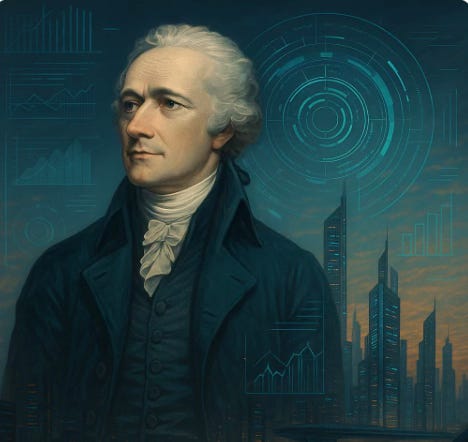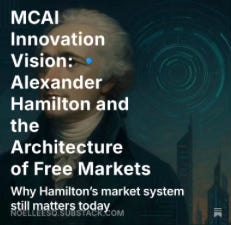MCAI Innovation Vision: 🔹 Alexander Hamilton and the Architecture of Free Markets
Why Hamilton’s market system still matters today
📜 Why Hamilton Matters Now
In an era where algorithms shape economies and markets outpace meaning, we find ourselves searching for foundations. Artificial intelligence accelerates decision-making, but hollows out consensus. Financial systems grow more complex, but trust in them grows thinner. Regulation trails innovation. Institutions drift. The scaffolding beneath capitalism is no longer self-evident.
That’s why Hamilton matters now.
Alexander Hamilton didn’t just argue for markets—he constructed the architecture that made them durable. In the aftermath of a revolution, amid fragmented states, unstable debt, and no national currency, Hamilton saw not despair, but opportunity. He engineered trust into the system. He didn’t wait for stability; he designed it. And he did so not through ideology, but through a deep understanding of how ambition, credibility, and structure could work together to create enduring prosperity.
Today, as we face a generational technological transformation, Hamilton’s genius offers something rare: not a metaphor, but a model.
💳 Credit as a Moral Foundation
Hamilton began with the thing most people overlooked—debt. At a time when the new nation was fractured and bankrupt, he insisted on consolidating and repaying every obligation. But to Hamilton, this wasn’t just a fiscal maneuver—it was a statement of character. A country that pays its debts can be trusted. A nation that honors its obligations builds moral capital. In his hands, credit became more than finance. It became a form of institutional memory—a signal that the United States could be believed, even before it could be powerful.
In a world now dominated by synthetic assets and hyper-speed speculation, Hamilton’s lesson is urgent: free markets are not sustained by liquidity, but by credibility. And credibility must be earned—through coherence, consistency, and moral clarity.
🏛 Institutions as Infrastructure for Freedom
Hamilton didn’t romanticize liberty. He understood that freedom, without structure, collapses into chaos. So he did what few dared: he built the institutions that could hold a market together. He created the First Bank of the United States, launched a national currency, and laid the foundations for a monetary system that could grow with the republic.
These were not abstract exercises in governance. They were instruments of economic freedom, designed to coordinate capital, manage risk, and make commerce predictable across a diverse and sprawling country. In the digital age—where financial platforms operate faster than governments and cryptocurrencies threaten national currencies—the principle still holds. Hamilton teaches us that free markets do not emerge from absence. They arise from design.
🛡 Strategic Protection as Sovereignty
In his landmark Report on Manufactures, Hamilton took another radical stance: he argued that a truly free nation could not rely on others for its basic industries. He called for tariffs, incentives, and early industrial policy—not to block trade, but to develop national capacity. He saw protection not as a rejection of competition, but as a temporary condition for long-term freedom.
We now live in an echo of that insight. With AI infrastructure, semiconductor supply chains, and energy sovereignty at the center of geopolitical tension, Hamilton’s voice rings louder than ever. Economic freedom requires strategic independence. And independence requires vision, planning, and the will to build.
🔁 Markets as Moral Machines
What made Hamilton’s mind so rare was not just its clarity—but its realism. He had no illusions about human nature. He didn’t expect virtue. Instead, he designed systems that could translate self-interest into public benefit. He aligned ambition with accountability. His architecture channeled energy into enterprise, speculation into investment, and personal gain into civic momentum.
Today, as we delegate more decisions to machines and optimize for scale over substance, Hamilton’s framework reminds us that markets can either reflect virtue—or magnify its absence. The difference lies in design. Incentives are moral levers. Structure is ethical code. For Hamilton, markets were not just efficient—they were ethical machines, if tuned correctly.
🌐 Conclusion: Rebuilding the Blueprint
Hamilton didn’t leave behind a theory. He left behind a living system—a model of how free societies could harness risk, reward, and responsibility to build something enduring. His institutions turned an idea into an engine. His credibility strategy turned a nation into an investment. His foresight turned ambition into alignment.
This is the kind of vision we need now.
As artificial intelligence redefines cognition and power, as financial systems decouple from human intention, we don’t need nostalgia. We need structure. Not to slow the future—but to shape it. Like Hamilton, we must design systems that embed trust, reward integrity, and scale wisely.
His genius wasn’t in what he theorized. It was in what he built.
In the age of AI, we must build again.
Prepared by Noel Le, Architect of MindCast AI LLC. Noel holds a background in law and economics. noel@mindcast-ai.com, www.linkedin.com/in/noelleesq/




